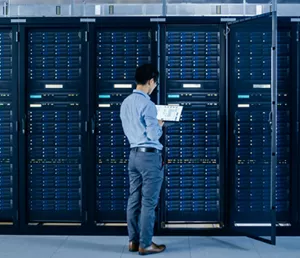
Unlock Data Clarity with VSP One - Infographic
Virtual Storage Platform One Software Defined Block Storage
Hybrid Cloud Ready Software-Defined Storage for distributed block applications drives business agility and cost savings

Unlock Data Clarity with VSP One - Infographic
Hybrid Cloud Ready Software-Defined Storage for distributed block applications drives business agility and cost savings
Physical locality for applications is irrelevant as you evolve cloud delivery platforms.
API ready plug-ins for Kubernetes plus Terraform integrations for orchestration promotes efficient storage administration.
99.999% uptime eliminates downtime and data encrypted at rest provides industry-leading security.
AI powered by same SVOS and AIOPS for a common data and control plane for maximum flexibility.
Available on the AWS Marketplace with multiple subscription-based software licensing options.
Cloud-based integrations with Clear Sight for observability and timely insights across block, file and object.
Multiple autonomous zones and replication provide flexibility, scalability and performance for your data across hybrid cloud environments.
We specialize in constructing contemporary hybrid cloud systems, where Software Defined Storage is an integral architectural element. Experience total data freedom without breaking the bank.
Ensure your application SLAs are met resulting in always-on applications. Rebuilds, snapshots, replication focused user base with a RAS framework.

Unleash data’s full potential with software-defined block storage that lets traditional and modern applications coexist
Eliminate the need for high-priced proprietary storage hardware.

Consistent, streamlined multi-cloud data storage
Run modern applications, with rapid growth pattens, alongside traditional workloads.

Virtual Storage Platform One, Explained
Storage Efficiencies from granular persistent storage support.

Data is always evolving but now is the time for revolution!
Designed for performance and scale driving business agility and elasticity for improved collaboration and communication.

Accelerate the speed of business with software-defined storage, driving agility and savings.
Get massive elastic storage infrastructure, reduce your storage footprint cost-effectively (improved cost/IOPS) and support for a multi-cloud platform.

7 Ways to Reduce Your CO2 Footprint & Save Money - Ebook
Control and manage multiple storage resources in one window for dev/test environments. Unified storage management with CI/CD integration.

VSP One SDS Powers Application Development and Testing
Designed for agility and elasticity where traditional and modern applications coexist, SDS drives petabyte scale and accelerated performance for distributed applications all humming on x86 servers.

Maximize productivity, drive petabyte scale with flexible capacity and granular performance with low latency.

A common control plane for proactive and predictive business operations removes data silos, minimizing platform complexity.

Implement a patented Polyphased Erasure Coding for seamless data mobility and governance at the speed of need.
Hitachi VSP One SDS Block for Cloud allows you to choose from two methods to pay for your cloud usage; Pay as you go (PayGo) and a Bring Your Own License (BYOL). No matter which payment method you choose, Hitachi VSP One SDS Block for Cloud offers a seamless and convenient way to leverage the power of cloud computing.

Pay for the amount of resources you consume for VSP One SDS Block licenses via AWS. AWS infrastructure services and Elastic Cloud 2 (EC2) are purchased directly from Amazon Web Services (AWS), and are required.

Purchase licenses directly from Hitachi Vantara for Hitachi VSP One SDS Block for Cloud on AWS. This provides you the flexibility to move your licenses to a different platform in the future.

By 2027, more than 90% of global organizations will be running containerized applications in production.*

Scale out distributed block and enterprise-class software. Manage, analyze, and protect with VSP One data services, petabyte scale and agility, and accelerated performance.

Achieve cost efficient migrations with SDS Cloud available on the AWS Marketplace with licensing choices, efficient data compression, and secure, encrypted data protection.
Virtual storage typically refers to pooling physical storage into one or more logical drives. To the requester the pool often appears as single storage device. Usually an application manages the devices. This virtualization software intercepts requests for storage and uses a map to find or save the data to the appropriate physical device.
Software-defined storage (SDS) is a more comprehensive service driven approach to storage virtualization. SDS solutions separate the storage control plane from the data plane providing the flexibility to scale storage across on-prem and the cloud (hybrid cloud) without impacting the management layer. Providing APIs for automation and application testing applications to request and release resources, allows SDS solutions to provide lower TCO and faster time to implementation for application and dev teams. SDS provides a complimentary addition to traditional storage in today’s enterprises while offering the scalability and flexibility required by today’s modern applications.
Software-defined storage (SDS) architecture separates storage management software (control plane) from the underlying hardware (storage plane), creating a flexible and scalable storage environment. Key components include:
The VSP One platform allows you to take advantage of an SDS architecture. Powered by the Hitachi Storage Operating System (SVOS) and managed through the Ops Center management control plane, VSP One delivers unparalleled performance, sustainability, and data management intelligence for modern enterprises.
Software-defined storage (SDS) differs from traditional storage in several key aspects:
Virtual Storage Platform One Software-Defined Storage (VSP One SDS) is Hitachi Vantara's flexible, scalable storage solution for modern data management across hybrid cloud environments.
The platform offers exceptional scalability, allowing organizations to expand storage resources seamlessly from terabytes to petabytes without complex infrastructure redesigns. Its centralized management through Hitachi Ops Center simplifies storage administration, reducing operational complexity and enabling IT teams to manage diverse storage environments from a single interface.
It includes two key products:
VSP One SDS features a single data plane running across all environments, centralized management through Hitachi Ops Center, and a 100% data availability guarantee. It supports various use cases, including:
VSP One SDS empowers organizations to optimize their hybrid cloud infrastructure while ensuring high performance, security, and flexibility across on-premises and cloud environments.
Hitachi Vantara ensures data security and uptime with their Software-Defined Storage (SDS) solutions through a comprehensive approach:
Hitachi Vantara's Software-Defined Storage (SDS) offers several AI and automation features:
These features enhance efficiency, reduce costs, and maintain high performance across hybrid cloud storage environments. For more details, explore our VSP One SDS Buyer's Guide and VSP One SDS product page.
Traditional storage runs on purpose build appliance hardware where data protection is done with RAID where SDS runs on Commodity based x86 Systems where data protection is done with software mirroring and Erasure Coding (HPEC for Us).

A Buyer’s Guide to Hitachi Vantara Virtual Storage Platform One SDS

Virtual Storage Platform One, Software-Defined Block Storage

Accelerate the speed of business with software-defined storage, driving agility and savings.

VSP One SDS Specifications

The Datacenter Revolution is Now

Top 10 Reasons VSP One SDS Block Storage Drives Business Agility and Cost Savings

Unlock Data Clarity with VSP One - Infographic

Hitachi Vantara Professional Services Maximize the Value of Your VSP One SDS Block Investment

Hitachi Vantara Professional Services - Maximize the Value of Your VSP One SDS Cloud Investment

Boost App Development with Software-Defined Storage

Unleash the Power of Your Data: Virtual Storage Platform One

Hitachi Vantara VSP One SDS Enhances Data Protection with Async Replication and Multi-AZ Support

DCIG Top 5 Enterprise SDS Block Storage Solutions

DCIG Report: Hitachi Vantara VSP One Block Solution Profile

ESG eBook — Consistent, Streamlined Multi-cloud Data Storage with Virtual Storage Platform One

Explore how Hitachi Ops Center Protector automates data protection, snapshots, replication, and business continuity